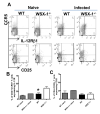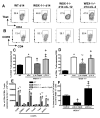IL-27 receptor signaling regulates CD4+ T cell chemotactic responses during infection
- PMID: 23536628
- PMCID: PMC3886378
- DOI: 10.4049/jimmunol.1202916
IL-27 receptor signaling regulates CD4+ T cell chemotactic responses during infection
Abstract
IL-27 exerts pleiotropic suppressive effects on naive and effector T cell populations during infection and inflammation. Surprisingly, however, the role of IL-27 in restricting or shaping effector CD4(+) T cell chemotactic responses, as a mechanism to reduce T cell-dependent tissue inflammation, is unknown. In this study, using Plasmodium berghei NK65 as a model of a systemic, proinflammatory infection, we demonstrate that IL-27R signaling represses chemotaxis of infection-derived splenic CD4(+) T cells in response to the CCR5 ligands, CCL4 and CCL5. Consistent with these observations, CCR5 was expressed on significantly higher frequencies of splenic CD4(+) T cells from malaria-infected, IL-27R-deficient (WSX-1(-/-)) mice than from infected wild-type mice. We find that IL-27 signaling suppresses splenic CD4(+) T cell CCR5-dependent chemotactic responses during infection by restricting CCR5 expression on CD4(+) T cell subtypes, including Th1 cells, and also by controlling the overall composition of the CD4(+) T cell compartment. Diminution of the Th1 response in infected WSX-1(-/-) mice in vivo by neutralization of IL-12p40 attenuated CCR5 expression by infection-derived CD4(+) T cells and also reduced splenic CD4(+) T cell chemotaxis toward CCL4 and CCL5. These data reveal a previously unappreciated role for IL-27 in modulating CD4(+) T cell chemotactic pathways during infection, which is related to its capacity to repress Th1 effector cell development. Thus, IL-27 appears to be a key cytokine that limits the CCR5-CCL4/CCL5 axis during inflammatory settings.
Figures






Similar articles
-
WSX-1 signalling inhibits CD4⁺ T cell migration to the liver during malaria infection by repressing chemokine-independent pathways.PLoS One. 2013 Nov 7;8(11):e78486. doi: 10.1371/journal.pone.0078486. eCollection 2013. PLoS One. 2013. PMID: 24244314 Free PMC article.
-
IL-27 receptor signaling regulates memory CD4+ T cell populations and suppresses rapid inflammatory responses during secondary malaria infection.Infect Immun. 2014 Jan;82(1):10-20. doi: 10.1128/IAI.01091-13. Epub 2013 Oct 7. Infect Immun. 2014. PMID: 24101691 Free PMC article.
-
Essential role for IL-27 receptor signaling in prevention of Th1-mediated immunopathology during malaria infection.J Immunol. 2010 Aug 15;185(4):2482-92. doi: 10.4049/jimmunol.0904019. Epub 2010 Jul 14. J Immunol. 2010. PMID: 20631310
-
The power of combinatorial immunology: IL-12 and IL-12-related dimeric cytokines in infectious diseases.Med Microbiol Immunol. 2004 Feb;193(1):1-17. doi: 10.1007/s00430-003-0186-x. Epub 2003 Jun 27. Med Microbiol Immunol. 2004. PMID: 12836019 Review.
-
The role of chemokines as inflammatory mediators in chronic hepatitis C virus infection.J Viral Hepat. 2007 Oct;14(10):675-87. doi: 10.1111/j.1365-2893.2006.00838.x. J Viral Hepat. 2007. PMID: 17875002 Review.
Cited by
-
Oral delivery of oligomeric procyanidins in Apple Poly® enhances type I IFN responses in vivo.J Leukoc Biol. 2014 May;95(5):841-847. doi: 10.1189/jlb.0513296. Epub 2014 Jan 13. J Leukoc Biol. 2014. PMID: 24421266 Free PMC article. Clinical Trial.
-
Parasite-Specific CD4+ IFN-γ+ IL-10+ T Cells Distribute within Both Lymphoid and Nonlymphoid Compartments and Are Controlled Systemically by Interleukin-27 and ICOS during Blood-Stage Malaria Infection.Infect Immun. 2015 Oct 12;84(1):34-46. doi: 10.1128/IAI.01100-15. Print 2016 Jan. Infect Immun. 2015. PMID: 26459508 Free PMC article.
-
IL-27 signalling regulates glycolysis in Th1 cells to limit immunopathology during infection.PLoS Pathog. 2020 Oct 13;16(10):e1008994. doi: 10.1371/journal.ppat.1008994. eCollection 2020 Oct. PLoS Pathog. 2020. PMID: 33049000 Free PMC article.
-
Role of Chemokines and Trafficking of Immune Cells in Parasitic Infections.Curr Immunol Rev. 2013;9(3):157-168. doi: 10.2174/1573395509666131217000000. Curr Immunol Rev. 2013. PMID: 25383073 Free PMC article.
-
Identification of the correlations between interleukin-27 (IL-27) and immune-inflammatory imbalance in preterm birth.Bioengineered. 2021 Dec;12(1):3201-3218. doi: 10.1080/21655979.2021.1945894. Bioengineered. 2021. PMID: 34224308 Free PMC article.
References
-
- Yoshida H, Nakaya M, Miyazaki Y. Interleukin 27: a double-edged sword for offense and defense. J Leukoc Biol. 2009;86:1295–303. - PubMed
-
- Hall AO, Silver JS, Hunter CA. The immunobiology of IL-27. Adv Immunol. 2012;115:1–44. - PubMed
-
- Findlay EG, Greig R, Stumhofer JS, Hafalla JC, de Souza JB, Saris CJ, Hunter CA, Riley EM, Couper KN. Essential role for IL-27 receptor signaling in prevention of Th1-mediated immunopathology during malaria infection. J Immunol. 2010;185:2482–92. - PubMed
-
- Villarino A, Hibbert L, Lieberman L, Wilson E, Mak T, Yoshida H, Kastelein RA, Saris C, Hunter CA. The IL-27R (WSX-1) is required to suppress T cell hyperactivity during infection. Immunity. 2003;19:645–55. - PubMed
-
- Hamano S, Himeno K, Miyazaki Y, Ishii K, Yamanaka A, Takeda A, Zhang M, Hisaeda H, Mak TW, Yoshimura A, Yoshida H. WSX-1 is required for resistance to Trypanosoma cruzi infection by regulation of proinflammatory cytokine production. Immunity. 2003;19:657–67. - PubMed
Publication types
MeSH terms
Substances
Grants and funding
- G0900487/MRC_/Medical Research Council/United Kingdom
- 004161/BB_/Biotechnology and Biological Sciences Research Council/United Kingdom
- BB/I020950/2/BB_/Biotechnology and Biological Sciences Research Council/United Kingdom
- 020950/BB_/Biotechnology and Biological Sciences Research Council/United Kingdom
- BB/G004161/1/BB_/Biotechnology and Biological Sciences Research Council/United Kingdom
LinkOut - more resources
Full Text Sources
Other Literature Sources
Medical
Molecular Biology Databases
Research Materials

